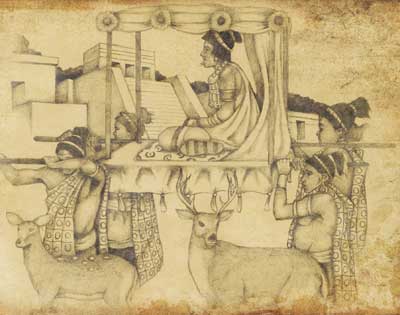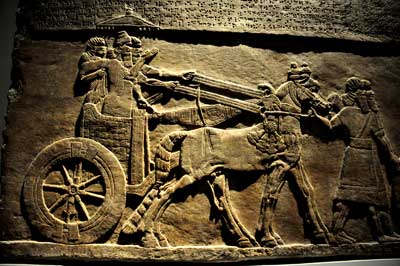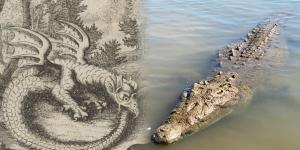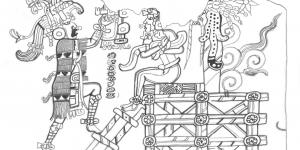You are here
What is the Nature and Use of Chariots in the Book of Mormon?

Alma 18:9
The Know
In the minds of most people today, the word chariot conjures up images of warriors riding two-wheeled, horse drawn war-chariots into battle. In the Book of Mormon, however, chariots are never actually mentioned in a battle context.1 Sifting out references to Old World quotations,2 there are only three occasions wherein chariots appear in the Book of Mormon:
- Alma 18:9–12: Ammon “made ready the horses and the chariots” (v. 12), in accordance with King Lamoni’s command that his servants “should prepare his horses and chariots, and conduct him forth to the land of Nephi” so that he could attend “a great feast” hosted by his father and overking.3
- Alma 20:4–7: Lamoni again had his servants “make ready his horses and his chariots” (v. 6), this time so that he could visit a political ally4 and “flatter” him into releasing Ammon’s brothers (v. 4).
- 3 Nephi 3:22: Chariots are included as part of a list of livestock and provisions taken by the Nephites when they left Zarahemla and withdrew for seven years into a more secure site as a defensive tactic against the Gadianton Robbers.
These few references all occur within a small window of time from ca. 90 BC–AD 16, suggesting that, overall, chariots were not widely or frequently used among Book of Mormon peoples.5 Only two of these are in a definable context: both times when Lamoni asks for his chariots to be prepared, “the occasion is a formal state visit.”6 While “horses” are mentioned with chariots, chariots are never explicitly pulled by horses or any other animal.
Due to the limited use and reference, it is hard to be certain about the nature of chariots in the Book of Mormon. Wheeled vehicles, as chariots are typically assumed to be, are thus far unattested for any part of pre-Columbian America. Nonetheless, in the late 19th century, pioneering archaeologist Désiré Charnay reported finding what he called “chariots” in central Mexico.7 To be sure, what Charnay found were wheeled figurines or “toys,” nothing that could actually be ridden on. About 100 such figurines are known,8 largely dated between AD 600–1250.9
Careful study of these figurines “demonstrate that at least some Mesoamericans grasped not only the concept of the wheel but also the concept of actual wheeled vehicles.”10 According to a pair of non-LDS Mesoamericanists, these figurines demonstrate that “the principle of using wheels to facilitate horizontal movement was familiar to at least some peoples of Pre-Columbian Mesoamerica.”11 In the ancient Near East, similar figurines are known to have “imitated full-scale wagons,”12 suggesting, perhaps, that the same is true in Mesoamerica.13
Alternatively, Charnay’s unconventional use of the word “chariot” invites other possibilities. The rare Hebrew word afiryon, meaning litter, palanquin, or sedan chair,14 is translated as “chariot” in the KJV (Song of Solomon 3:9). This was a non-wheeled vehicle wherein a rider was carried by servants. Just such litters or palanquins were known among pre-Columbian Mesoamericans. “Maya kings were borne in litters, often made of simple rushes and carried by just two bearers.”15 John L. Sorenson noted, “This form of transport was reserved for nobility and others of the upper social levels.”16
These litters were used for royal processions and nobles or dignitaries making a political visit. For instance, in 1542, after the Spanish conquest of the Maya region, “A throng of warriors escorting a young Maya lord seated in a palanquin” approached some Spanish sentries, “made signs that he had come in peace” and that he had brought food in what was apparently a diplomatic visit.17
A Classic Maya vase depicting the sacrifice of war prisoners shows a “visiting dignitary” who was “brought to the event in a litter.”18 The earliest known depiction of a Mesoamerican litter is Izapa Stela 21, dated to ca. 300–50 BC.19
With a litter, servants or bearers would “conduct [the king] forth” (Alma 18:9) in a royal procession. While no horse or draft animal was used to pull or carry the litter, an animal was commonly depicted traveling near the litter as part of the procession. For instance, LDS Mesoamericanist Mark Wright has pointed out that several Classic Maya vases depict a dog underneath the litter traveling as part of the entourage.20
Brant A. Gardner thus proposed, “The plausible underlying conveyance in the story of Ammon was a royal litter, accompanied in peacetime by the spiritual animal associated with the king.”21 In other words, Ammon would have prepared “horses” to travel with the king, while the servants “conduct him forth to the land of Nephi” (Alma 18:9) in his litter.
The Why

There are not always definitive answers to questions some may have about the Book of Mormon. These unsolved puzzles invite both faith and further learning if they are approached with patience, careful reading, and an open mind. Just as with the occurrence of the word “horse” in the text, there are opportunities to learn, explore, wonder, and grow in faith.22
The current state of archaeological knowledge is limited,23 and caution must be taken when evaluating negative evidence. LDS Mesoamerican archaeologist John E. Clark once explained: “Positive and negative evidence do not count the same,” because, “Given current means of verification, positive items are here to stay, but negative items may prove to be positive ones in hiding.”24 Several things mentioned in the Book of Mormon once considered missing have since proven to be in the right place at the right time all along.25 “It is in this light,” concluded Clark, “that we should consider many arguments against the Book of Mormon.”26
Archaeology currently shows that some peoples in pre-Columbian Mesoamerica did understand the conceptual principles behind wheeled vehicles, although there is no evidence that these were actually put into practice. Still, over a 600-year period (ca. AD 600–1250), it is likely that at least some attempt, however limited and short lived, would have been made to put the wheel into practical use.
Perhaps the brief time-period (the first centuries BC and AD) wherein chariots are mentioned in the Book of Mormon represents just such a limited, short-lived attempt, albeit at a much earlier time than current evidence for the wheeled figurines. Then the Nephites and Lamanites abandoned the technology because it lacked any practical advantages.27 A brief attempt at using the wheel that is quickly abandoned would be very difficult to find in the archaeological record.
Exploring the possibilities for chariots also reinforces the importance of reading scripture with an open mind. It takes humility and maturity to step away from long-held assumptions and read the scriptural text from a fresh perspective. Nonetheless, doing so while exploring questions in a historical context can provide clarity and understanding to Book of Mormon passages. As Charnay and the KJV translation of afiryon demonstrate, “chariot” can have broader meaning than what might typically come to mind. That usage can include non-wheeled vehicles like the litters used all throughout Mesoamerica clear back into Book of Mormon times.
Although this paints a very different image than what most readers have come to expect, conventional use of litters in Mesoamerica is consistent with the uses of chariots in the Book of Mormon. Furthermore, if Ammon was expecting to be one of the bearers of King Lamoni’s litter, thus having to “conduct him forth to the land of Nephi” on his shoulders (Alma 18:9), such a visual adds another layer of humility to this great missionary. He was literally willing to bear and carry those he had been called to serve.
Further Reading
Book of Mormon, see Book of Mormon Central, “Why are Horses Mentioned in the Book of Mormon? (Enos 1:21),” KnoWhy 75 (April 11, 2016).
Daniel Johnson, “‘Hard’ Evidence of Ancient American Horses,” BYU Studies Quarterly 54, no. 3 (2015): 149–179, esp. 154–157.
Brant A. Gardner, Traditions of the Fathers: The Book of Mormon as History (Salt Lake City, UT: Greg Kofford Books, 2015), 289–297.
John L. Sorenson, Mormon’s Codex: An Ancient American Book (Salt Lake City and Provo, UT: Deseret Book and Neal A. Maxwell Institute for Religious Scholarship, 2013), 350–361.
- 1. Brant A. Gardner, Traditions of the Fathers: The Book of Mormon as History (Salt Lake City, UT: Greg Kofford Books, 2015), 294: “Chariots never appear in the context of Book of Mormon warfare.”
- 2. 2 Nephi 12:7, stating “neither is there any end of their chariots” is a quotation of Isaiah 2:7; 3 Nephi 21:14 is a quotation of Micah 5:10.
- 3. An “overking” is the term scholars use for kings in Mesoamerica which ruler over subordinate kings. See Simon Martin and Nikolai Grube, Chronicle of the Maya Kings and Queens, 2nd edition (London, Eng.: Thames and Hudson, 2008), 20–21. This notion will be discussed in greater detail in KnoWhy 128.
- 4. In KnoWhy 131, the political connotations of the word “friend” will be discussed.
- 5. Brant A. Gardner, Second Witness: Analytical & Contextual Commentary on the Book of Mormon, 6 vols. (Salt Lake City, UT: Greg Kofford Books, 2007), 4:286, suggested that chariots “seem to be something reserved for … special occasions.”
- 6. Gardner, Second Witness, 4:286.
- 7. See John L. Sorenson, Mormon’s Codex: An Ancient American Book (Salt Lake City and Provo, UT: Deseret Book and Neal A. Maxwell Institute for Religious Scholarship, 2013), 350. Gardner, Traditions of the Fathers, 294 also points this out, and adds the detail that William Henry Holmes, an archaeologist and anthropologist for the Smithsonian Institute in the early-20th century also used “chariot” when referring to the figurines.
- 8. Sorenson, Mormon’s Codex, 351. Richard A. Diehl and Margaret D. Mandeville, “Tula and Wheeled Animal Effigies in Mesoamerica,” Antiquity 61, no. 232 (July 1987): 239 states that there were between 60–70 known by S.H. Boggs in 1973, and they report finding 79 fragments from at least 27, probably more, at Tula (p. 241). Thus, the total would be at least between 87–97, getting close to 100, not including any additional examples that may have been found since 1987.
- 9. Diehl and Mandeville, “Tula and Wheeled Animal Effigies,” 240–241. John L. Sorenson, Images of Ancient America: Visualizing Book of Mormon Life (Provo, UT: FARMS, 1998), 59 reported, “Mexican specimens date from as early as the first century AD,” however Diehl and Mandeville explained that while some may pre-date AD 600, none can be dated to this period with certainty.
- 10. Sorenson, Mormon’s Codex, 352. Sorenson similarly stated, “Mesoamericans conceptualized use of the wheel well in advance of their technological capability to take practical advantage of the idea” (pp. 354–355). For Sorenson’s full discussion of the data for wheels in Mesoamerica, see pp. 350–356.
- 11. Diehl and Mandeville, “Tula and Wheeled Animal Effigies,” 239.
- 12. Sorenson, Mormon’s Codex, 351.
- 13. Sorenson, Images of Ancient America, 59: “The usual interpretation of these objects by Mesoamericanist scholars is that while the prehistoric peoples obviously knew the principle of the wheel, for unknown reasons they never translated the idea into practical vehicles. Yet these same scholars celebrate the inventive capabilities of the early Americans. Would they have been familiar with these miniatures for at least fifteen hundred years without trying to make a practical vehicle?” 1500 years is an overstatement, given that wheeled figurines can only be confidently dated to the Postclassic (ca. AD 900–1540) and perhaps the late Classic (post-AD 600) period, and no later than AD 1250. Still, Sorenson makes a valuable point. It seems unlikely that a culture which clearly understood wheeled vehicles on a conceptual level for roughly 600 years never at least tried using more practical wheeled vehicles. This kind of argument is also made in Daniel Johnson, “‘Hard’ Evidence of Ancient American Horses,” BYU Studies Quarterly 54, no. 3 (2015): 154–157.
- 14. Ludwig Koehler and Walter Baumgartner, The Hebrew and Aramaic Lexicon of the Old Testament, 2 vols. (Leiden and Boston: Brill, 2001), 1:80.
- 15. Mary Miller and Karl Taube, An Illustrated Dictionary of the Gods and Symbols of Ancient Mexico and the Maya (London, Eng.: Thames and Hudson, 1993), 107.
- 16. Sorenson, Images of Ancient America, 58.
- 17. Robert J. Sharer and Loa P. Traxler, The Ancient Maya, 6th edition (Stanford, CA: Stanford University Press, 2006), 771.
- 18. Dorie Reents-Budet, Painting the Maya Universe: Royal Ceramics of the Classic Period (Durham, NC: Duke University Press and Duke University Art Museum, 1994), 262. The vase in question is K767 at http://research.mayavase.com/kerrmaya.html.
- 19. See V. Garth Norman, Izapa Sculpture, Part 1: Album, NWAF Papers, no. 30 (Provo, UT: New World Archaeological Foundation, Brigham Young University, 1973), plates 33–34; V. Garth Norman, Izapa Sculpture, Part 2: Text, NWAF Paper, no. 30 (Provo, UT: New World Archaeological Foundation, Brigham Young University, 1976), 122–127. For dating of the Izapan monuments, Norman, Izapa Sculpture, Part 1, 1 dates them to between 300 BC–AD 250. However, site excavators argued that they most likely date to the earlier part of this period, most likely ca. 300–50 BC, with some possibly dating to as late as AD 100. See Gareth W. Lowe, Thomas A. Lee Jr., and Eduardo Martinez Espinoza, Izapa: An Introduction to the Ruins and Monuments, NWAF Papers, no. 31 (Provo, UT: New World Archaeological Foundation, Brigham Young University, 1982), 23.
- 20. Comments from Mark Wright are found in James Stutz, “Mesoamerican Art & the ‘Horse’ Controversy,” at Lehi’s Library, April 16, 2008, online at https://lehislibrary.wordpress.com/2008/04/16/65/. Vases depicting dogs traveling with a litter are K594, K5534, and K6317 at http://research.mayavase.com/kerrmaya.html. Gardner has pointed out that in war scenes, the king in his litter is commonly accompanied by a fierce “battle beast,” typically thought to represent the king’s animal spirit alter-ego. Graffiti at Tikal, however, etching what eye-witnesses actually saw during ritual, suggests that the beasts were more than just imaginary, and that they accompanied the king in ritual processions as well as in war time situations. See Gardner, Traditions of the Fathers, 295–297; Gardner, Second Witness, 288–289.
- 21. Gardner, Traditions of the Fathers, 297.
- 22. On “horses” in the Book of Mormon, see Book of Mormon Central, “Why are Horses Mentioned in the Book of Mormon? (Enos 1:21),” KnoWhy 75 (April 11, 2016).
- 23. Mark Alan Wright, “The Cultural Tapestry of Mesoamerica,” Journal of the Book of Mormon and Other Restoration Scripture 22, no. 2 (2013): 6: “Literally thousands of archaeological sites dot the Mesoamerican landscape, the vast majority of which we know virtually nothing about, other than their locations. In the Maya area alone are approximately six thousand known sites, of which fewer than fifty have undergone systematic archaeological excavation …. Archaeologists estimate that less than 1 percent of ancient Mesoamerican ruins have been uncovered and studied, leaving much yet to learn.”
- 24. John E. Clark, “Archaeological Trends and the Book of Mormon Origins,” in The Worlds of Joseph Smith: A Bicentennial Conference at the Library of Congress, ed. John W. Welch (Provo, UT: BYU Press, 2006), 94.
- 25. See Book of Mormon Central, “How Can Barely in the Book of Mormon Feed Faith? (Mosiah 9:9),” KnoWhy 87 (April 27, 2016); Book of Mormon, “Did Ancient Israelites Write in Egyptian? (1 Nephi 1:2),” KnoWhy 4 (January 5, 2016). For several examples, see Matthew Roper, “Howlers Index,” at Ether’s Cave, (accessed May 24, 2016). Also see Kevin Christensen, “Hindsight on a Book of Mormon Historicity Critique,” FARMS Review 22, no. 2 (2010): 155–194; Clark, “Archaeological Trends,” 93–95.
- 26. Clark, “Archaeological Trends,” 95.
- 27. Scholars have long noted that the Mesoamerican topography and general lack of draft animals neutralized most advantages the wheel offered in other ancient settings. See Diehl and Mandeville, “Tula and Wheeled Animal Effigies,” 244–245. Also see Sorenson, Mormon’s Codex, 354–356. These same reasons would explain why any knowledge of the wheel that the Lehites might have brought with them seems to have disappeared quickly.
KnoWhy Citation
Related KnoWhys
Subscribe
Get the latest updates on Book of Mormon topics and research for free








